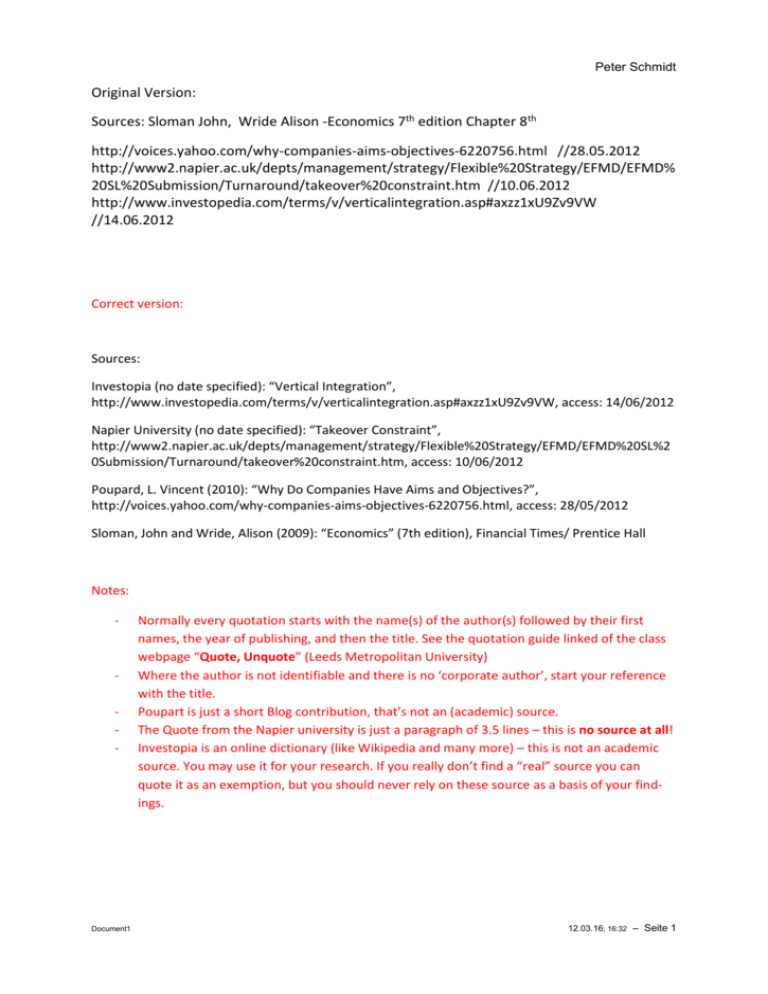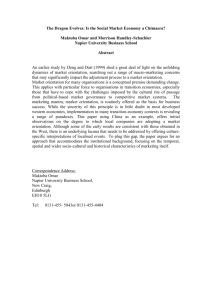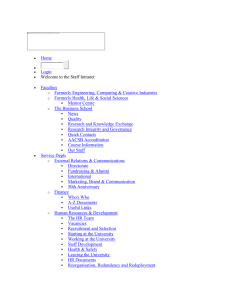example
advertisement

Peter Schmidt Original Version: Sources: Sloman John, Wride Alison -Economics 7th edition Chapter 8th http://voices.yahoo.com/why-companies-aims-objectives-6220756.html //28.05.2012 http://www2.napier.ac.uk/depts/management/strategy/Flexible%20Strategy/EFMD/EFMD% 20SL%20Submission/Turnaround/takeover%20constraint.htm //10.06.2012 http://www.investopedia.com/terms/v/verticalintegration.asp#axzz1xU9Zv9VW //14.06.2012 Correct version: Sources: Investopia (no date specified): “Vertical Integration”, http://www.investopedia.com/terms/v/verticalintegration.asp#axzz1xU9Zv9VW, access: 14/06/2012 Napier University (no date specified): “Takeover Constraint”, http://www2.napier.ac.uk/depts/management/strategy/Flexible%20Strategy/EFMD/EFMD%20SL%2 0Submission/Turnaround/takeover%20constraint.htm, access: 10/06/2012 Poupard, L. Vincent (2010): “Why Do Companies Have Aims and Objectives?”, http://voices.yahoo.com/why-companies-aims-objectives-6220756.html, access: 28/05/2012 Sloman, John and Wride, Alison (2009): “Economics” (7th edition), Financial Times/ Prentice Hall Notes: - - Document1 Normally every quotation starts with the name(s) of the author(s) followed by their first names, the year of publishing, and then the title. See the quotation guide linked of the class webpage “Quote, Unquote” (Leeds Metropolitan University) Where the author is not identifiable and there is no ‘corporate author’, start your reference with the title. Poupart is just a short Blog contribution, that’s not an (academic) source. The Quote from the Napier university is just a paragraph of 3.5 lines – this is no source at all! Investopia is an online dictionary (like Wikipedia and many more) – this is not an academic source. You may use it for your research. If you really don’t find a “real” source you can quote it as an exemption, but you should never rely on these source as a basis of your findings. 12.03.16; 16:32 – Seite 1 Peter Schmidt Original Version: Sources: Sloman John, Wride Alison -Economics 7th edition Chapter 8th http://voices.yahoo.com/why-companies-aims-objectives-6220756.html //28.05.2012 http://www2.napier.ac.uk/depts/management/strategy/Flexible%20Strategy/EFMD/EFMD% 20SL%20Submission/Turnaround/takeover%20constraint.htm //10.06.2012 http://www.investopedia.com/terms/v/verticalintegration.asp#axzz1xU9Zv9VW //14.06.2012 Correct version: Sources: Investopia (no date specified): “Vertical Integration”, http://www.investopedia.com/terms/v/verticalintegration.asp#axzz1xU9Zv9VW, access: 14/06/2012 Napier University (no date specified): “Takeover Constraint”, http://www2.napier.ac.uk/depts/management/strategy/Flexible%20Strategy/EFMD/EFMD%20SL%2 0Submission/Turnaround/takeover%20constraint.htm, access: 10/06/2012 Poupard, L. Vincent (2010): “Why Do Companies Have Aims and Objectives?”, http://voices.yahoo.com/why-companies-aims-objectives-6220756.html, access: 28/05/2012 Sloman, John and Wride, Alison (2009): “Economics” (7th edition), Financial Times/ Prentice Hall Notes: - - Document1 Normally every quotation starts with the name(s) of the author(s) followed by their first names, the year of publishing, and then the title. See the quotation guide linked of the class webpage “Quote, Unquote” (Leeds Metropolitan University) Where the author is not identifiable and there is no ‘corporate author’, start your reference with the title. Poupart is just a short Blog contribution, that’s not an (academic) source. The Quote from the Napier university is just a paragraph of 3.5 lines – this is no source at all! Investopia is an online dictionary (like Wikipedia and many more) – this is not an academic source. You may use it for your research. If you really don’t find a “real” source you can quote it as an exemption, but you should never rely on these source as a basis of your findings. 12.03.16; 16:32 – Seite 2






